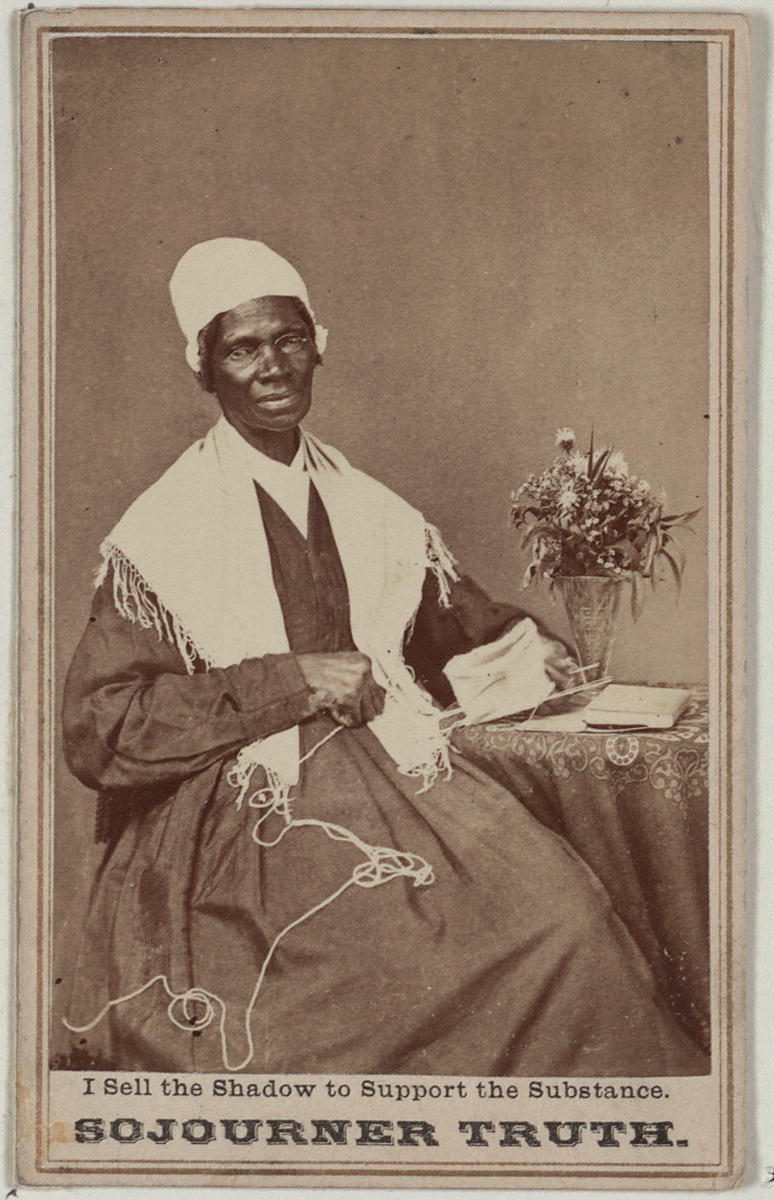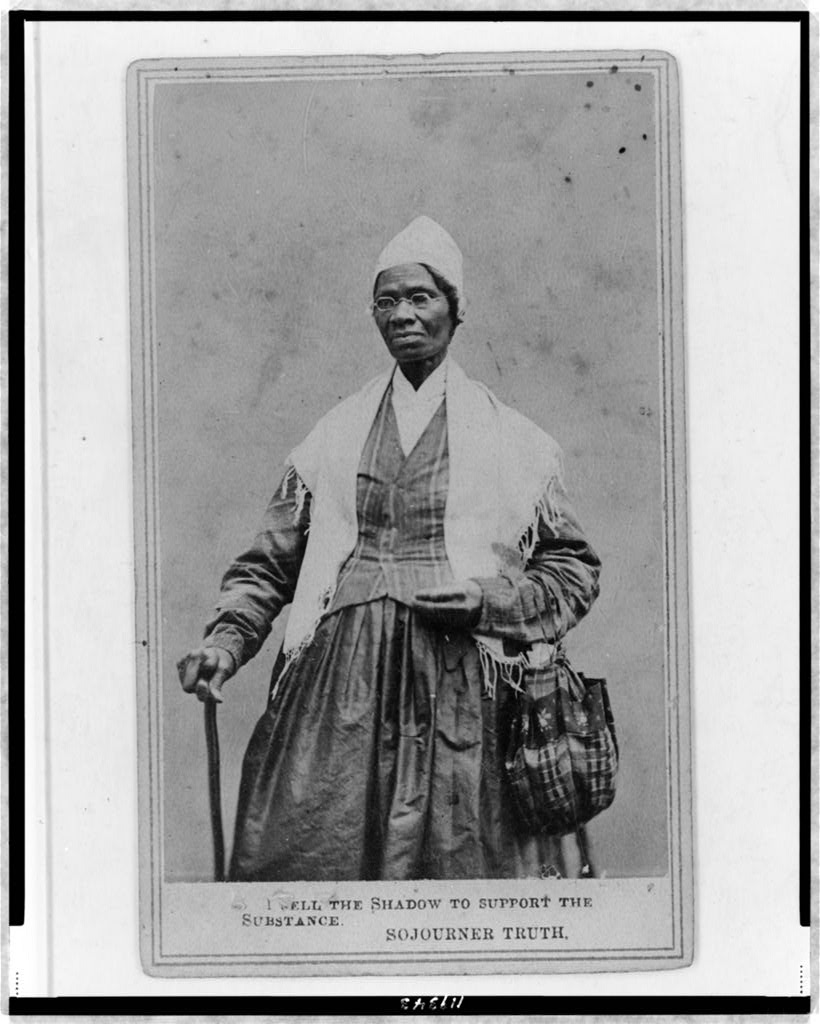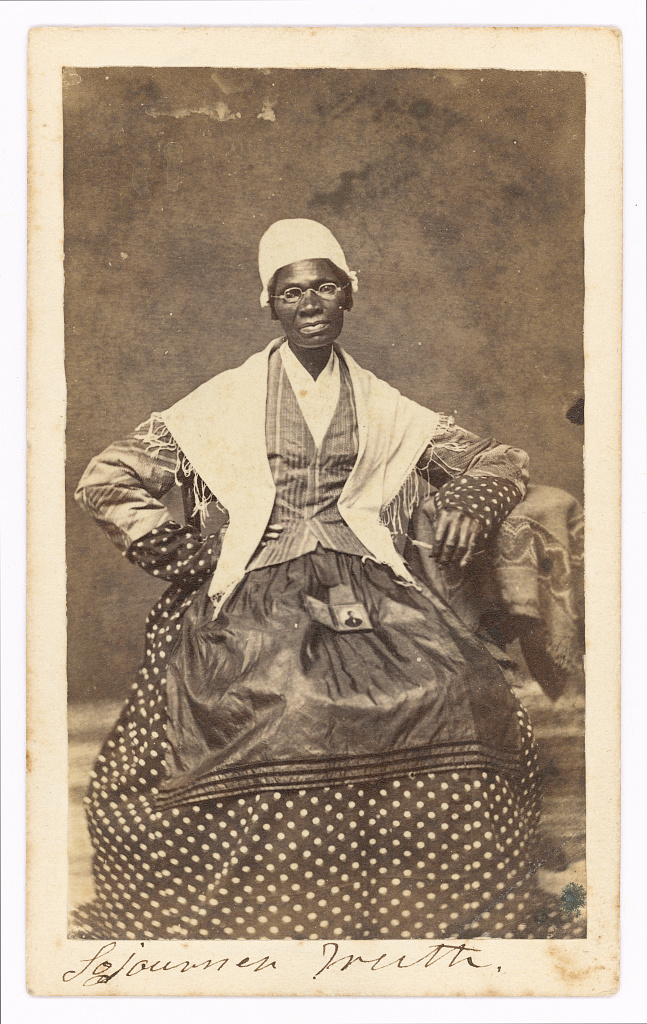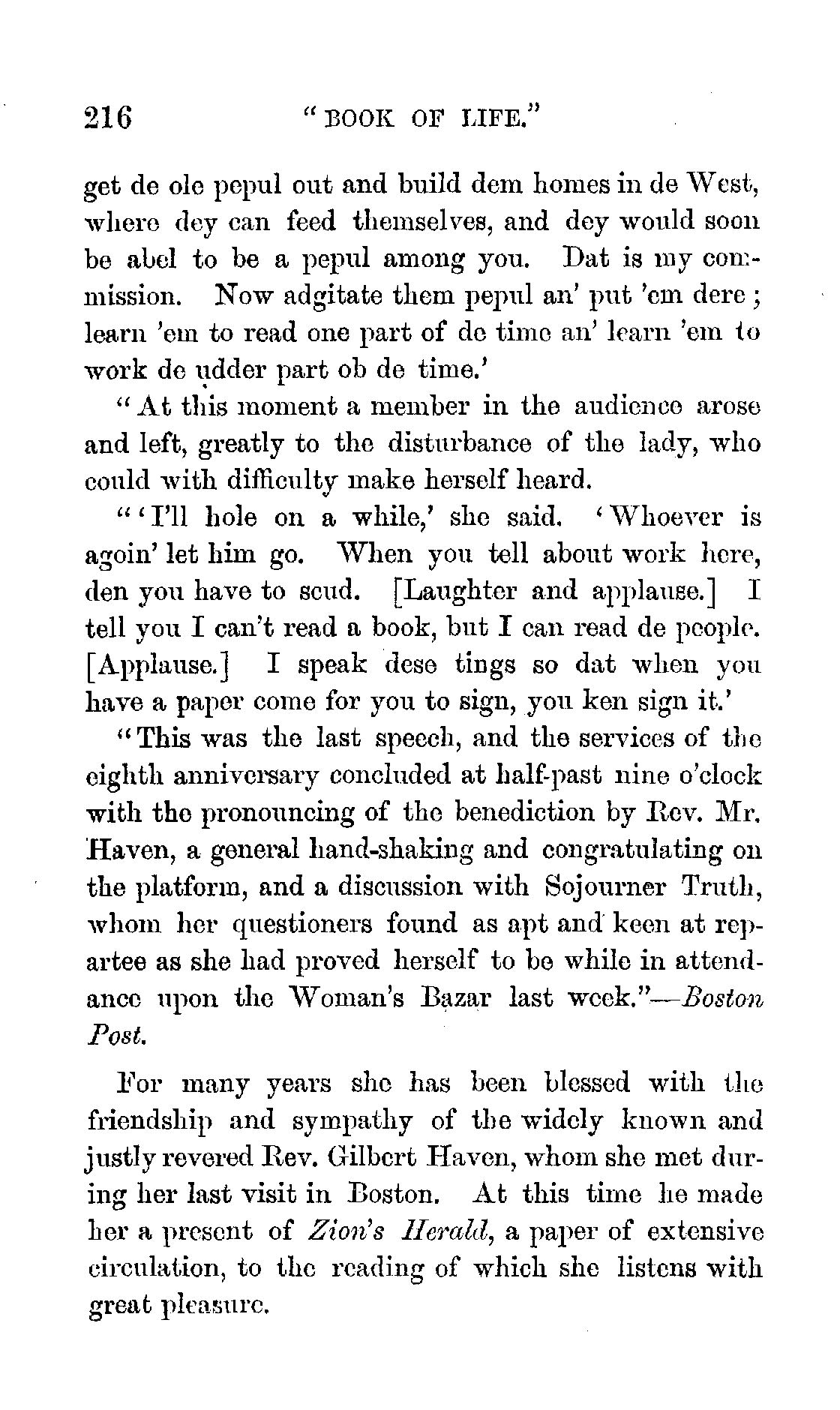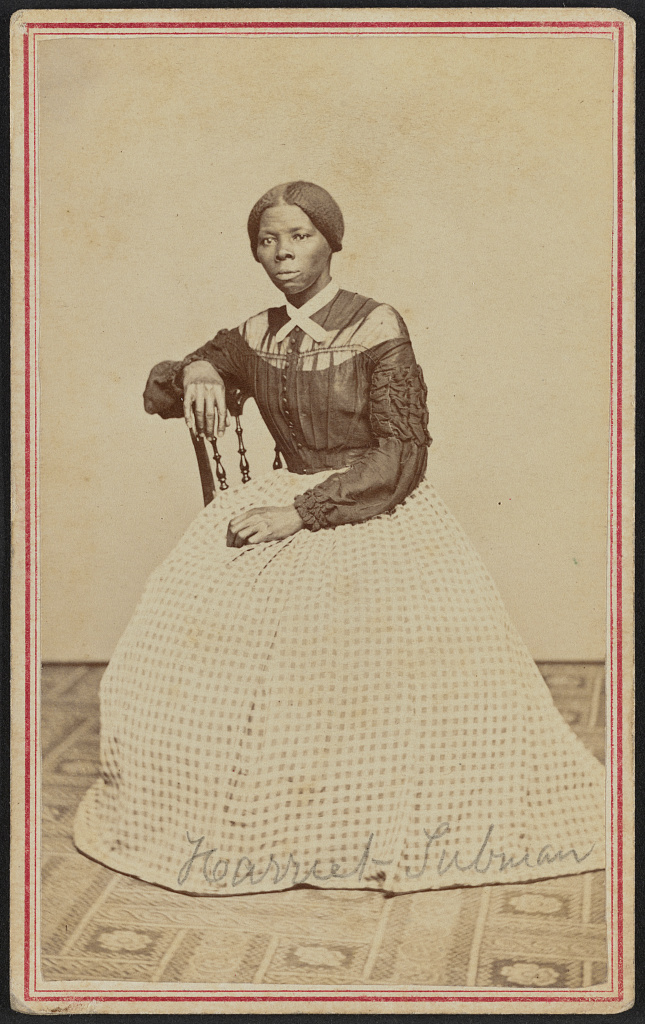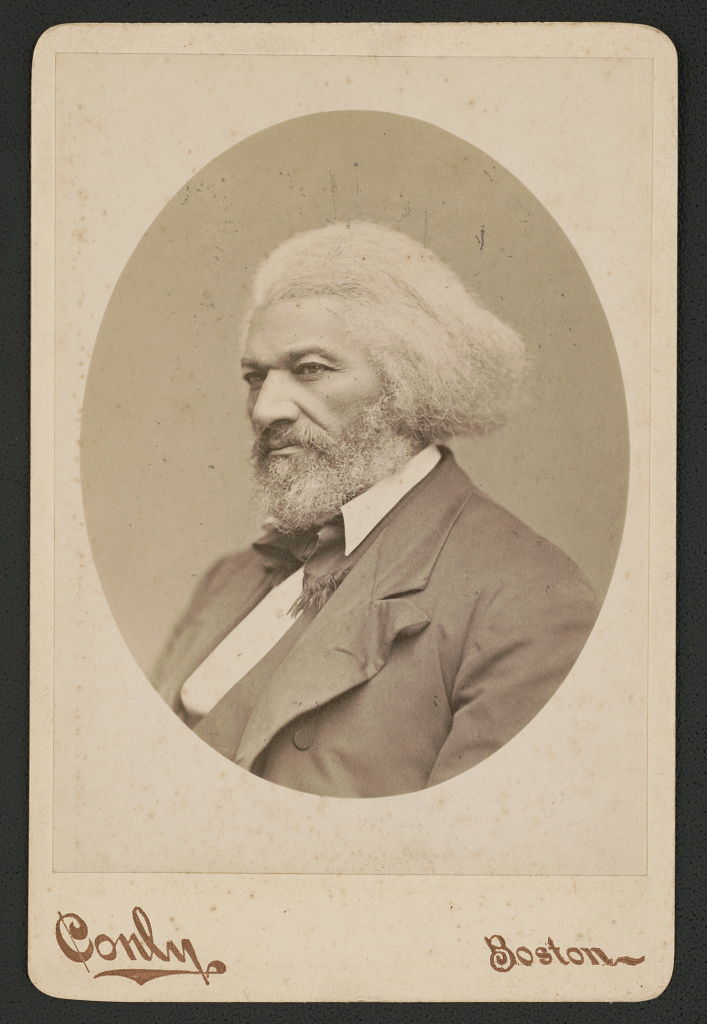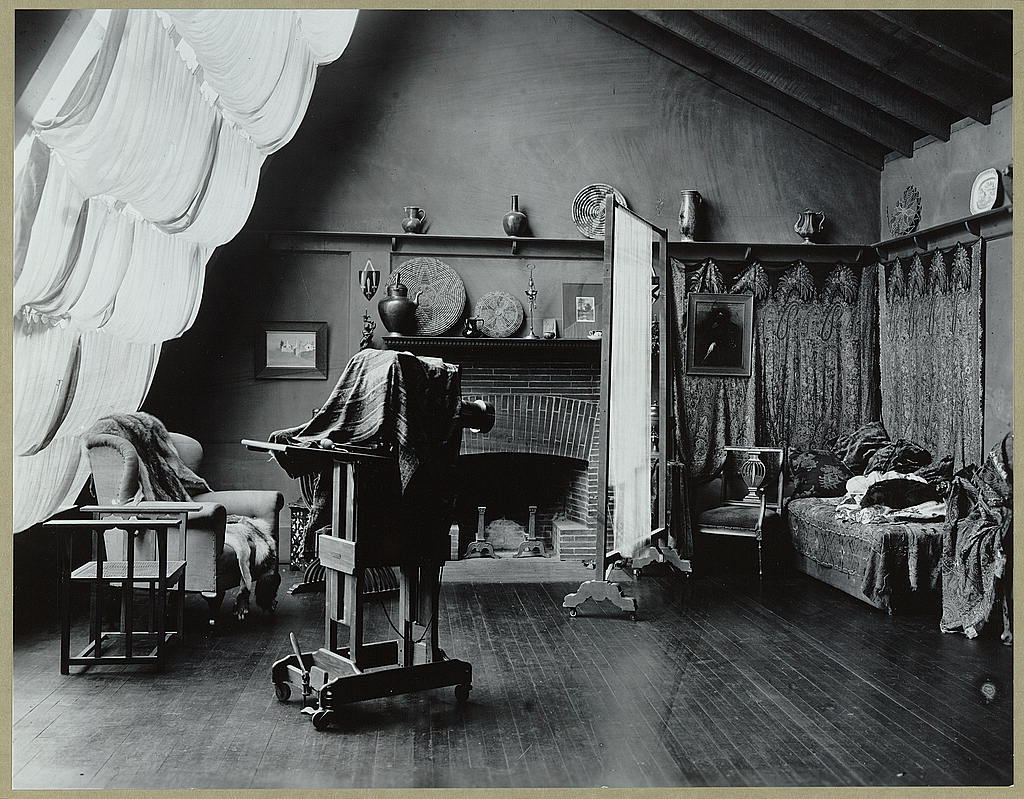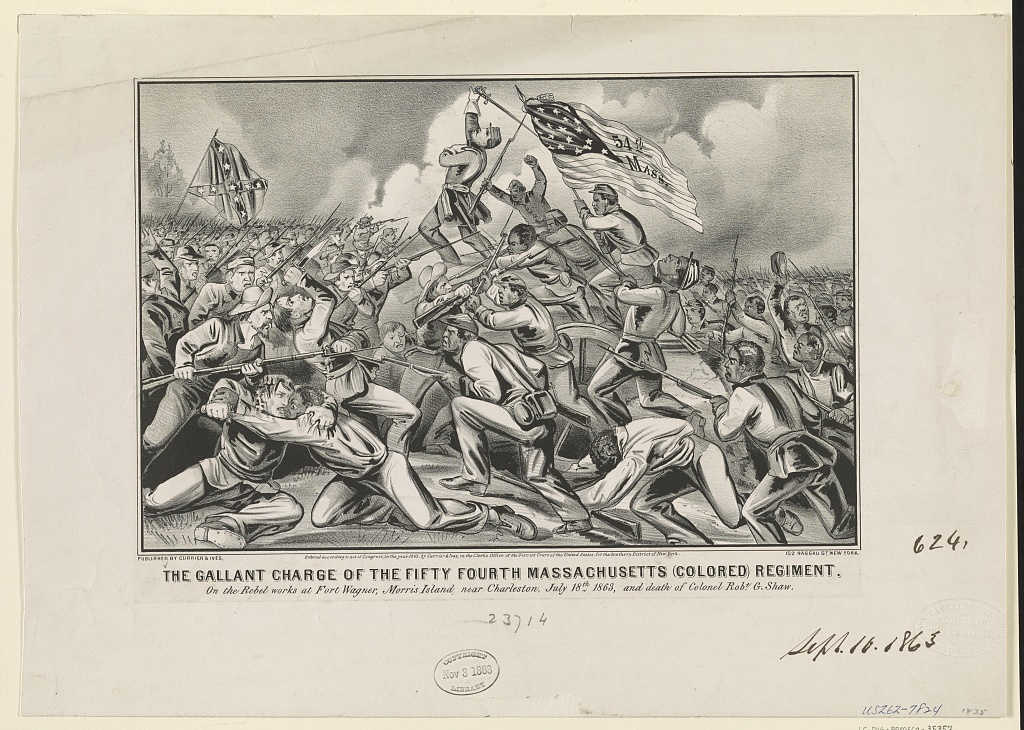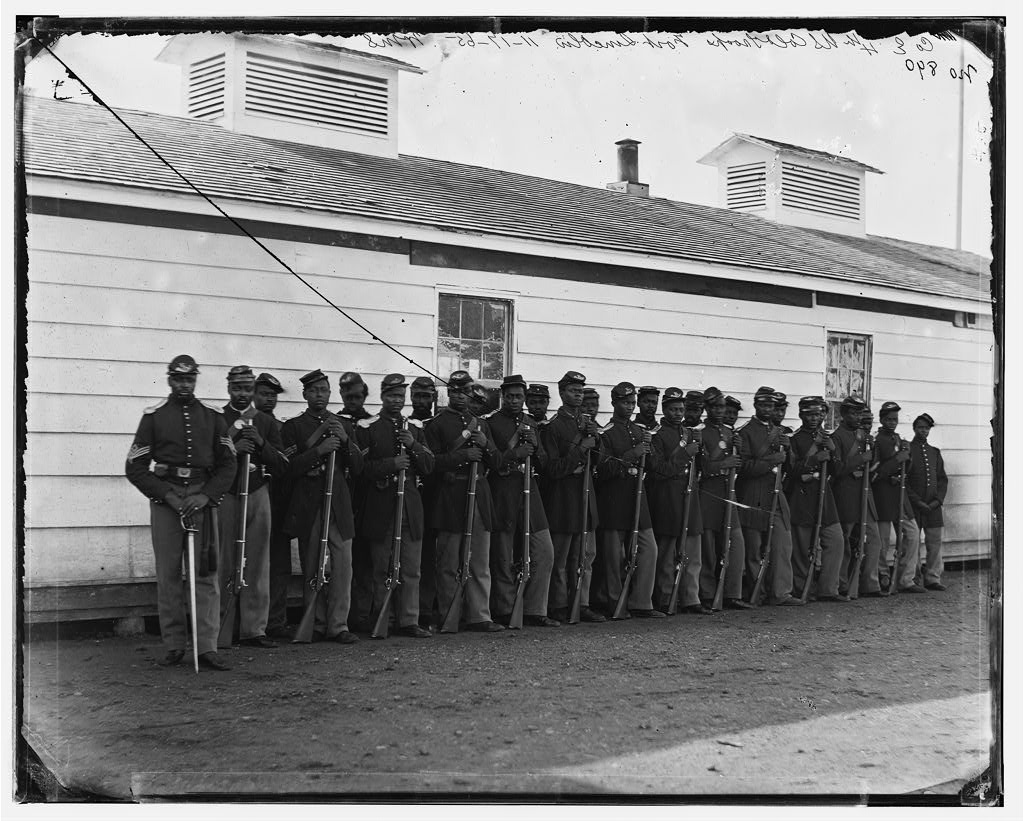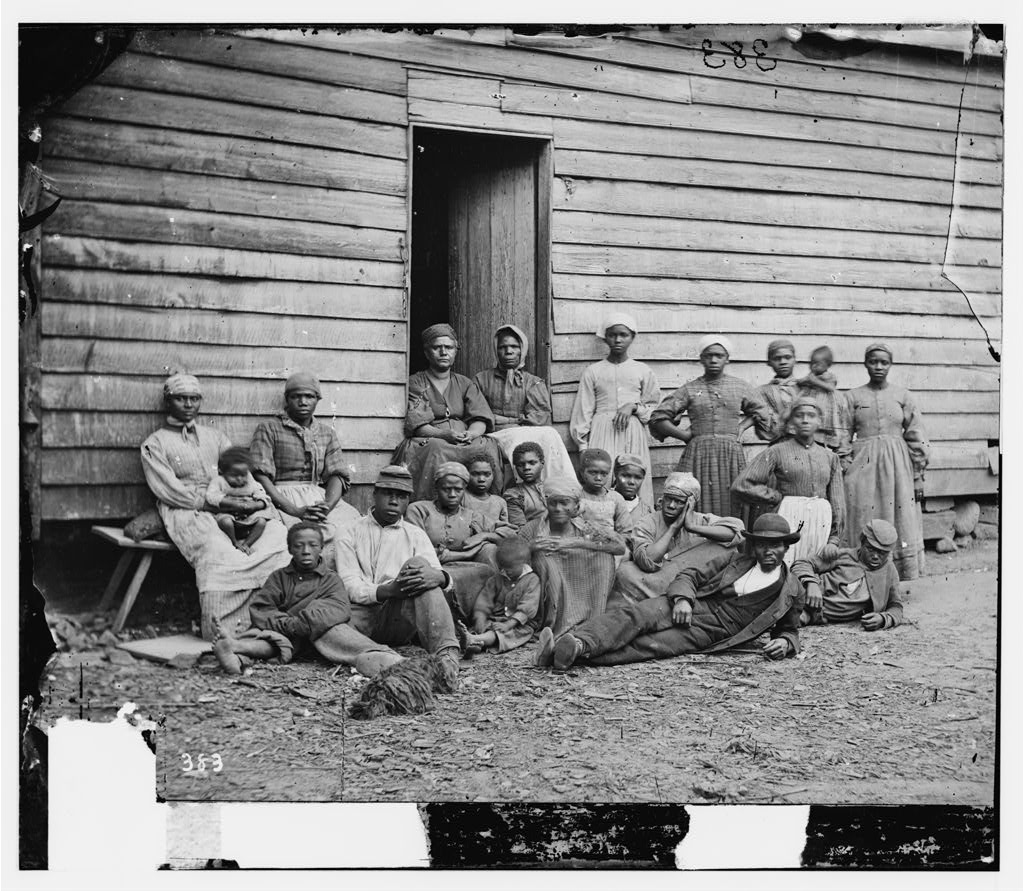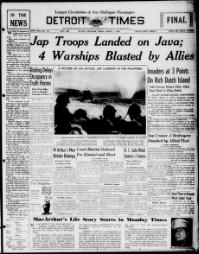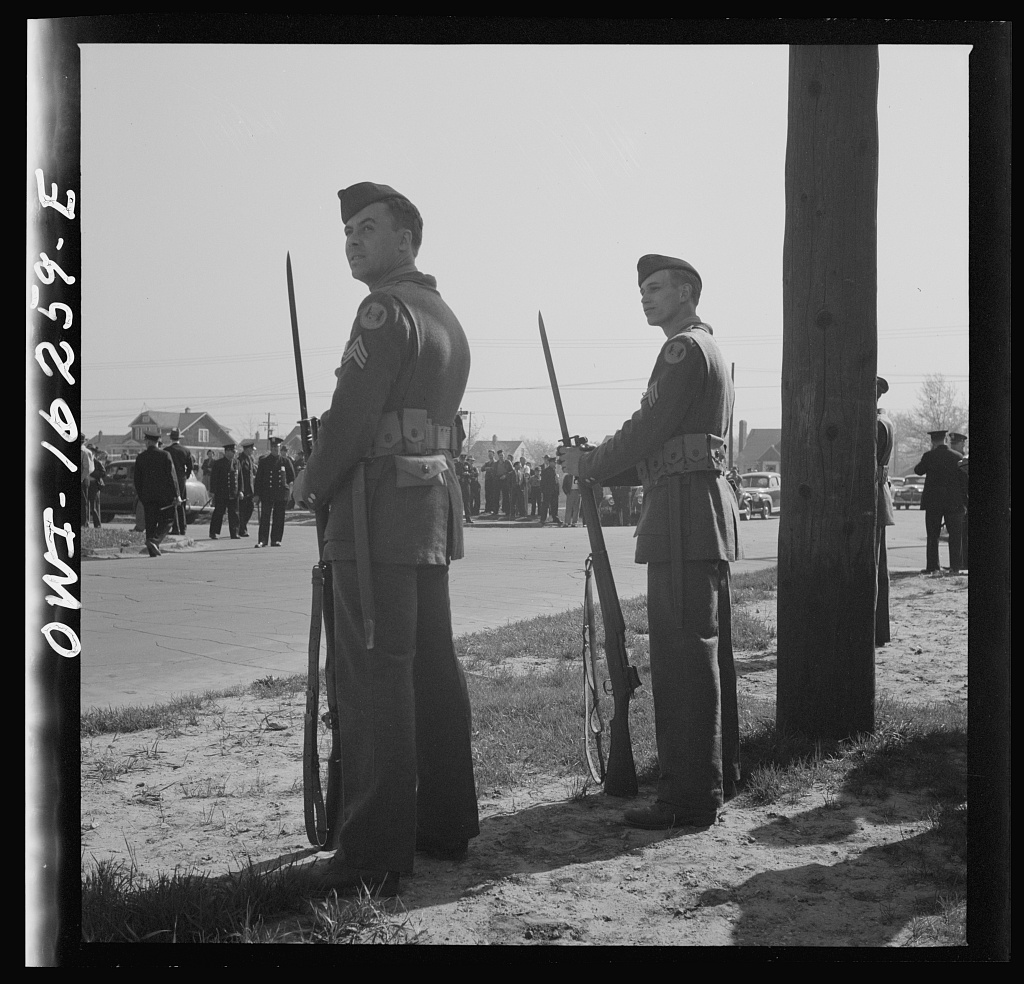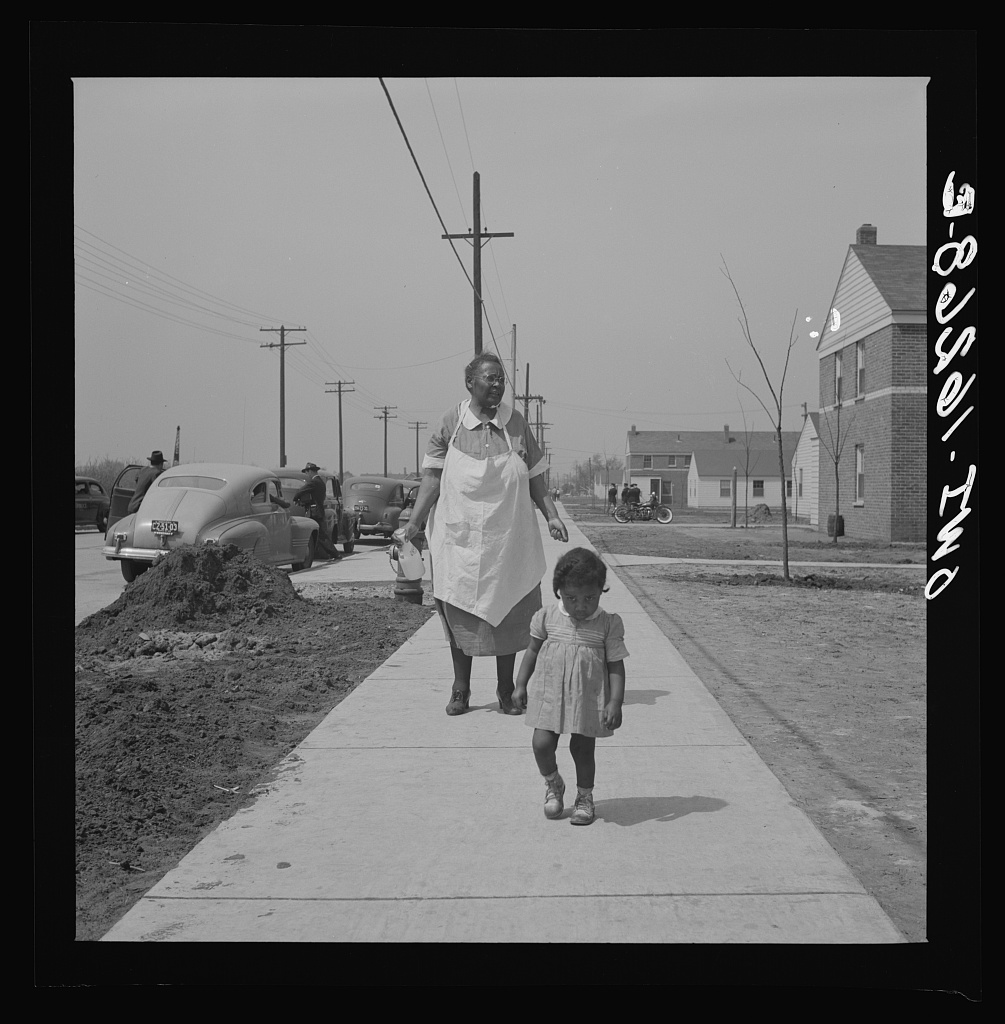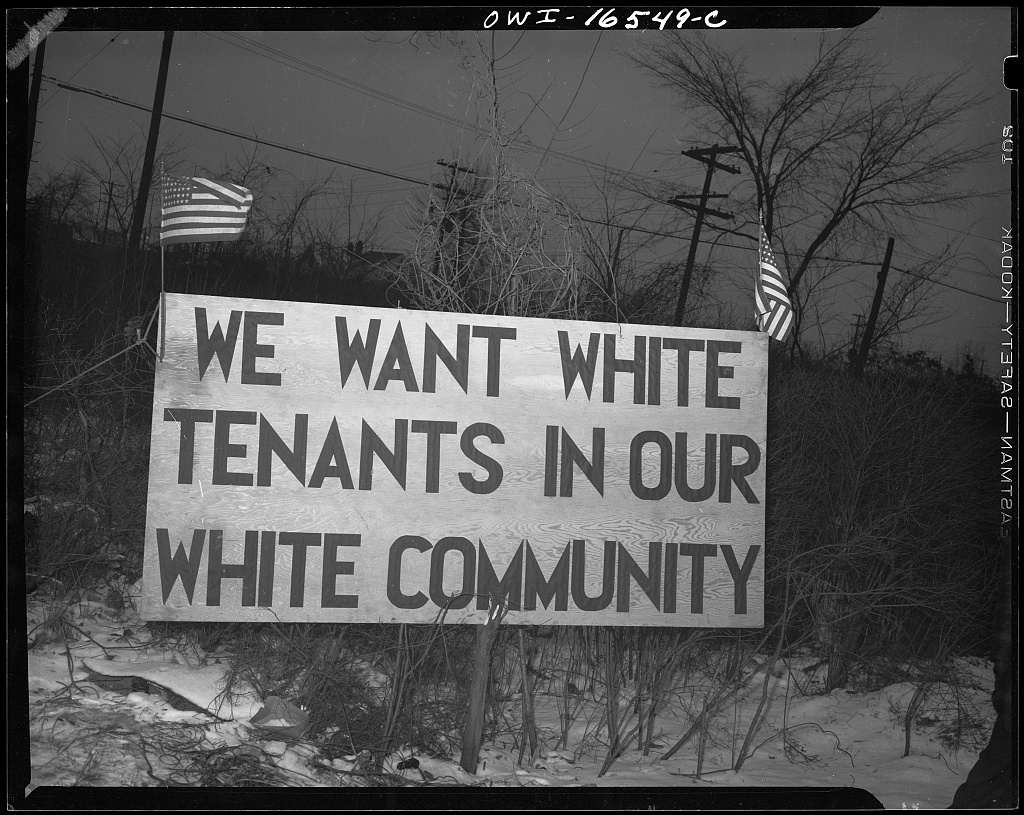This album was created by a member of the TPS Teachers Network, a professional social media network for educators, funded by a grant from the Library of Congress. For more information, visit tpsteachersnetwork.org.
Sojourner Truth and the Meaning of Literacy
Album Description
Sojourner Truth never learned to read or write, but her incredible power to communicate complicates our understanding of what it means to be literate.
⏱ 335 words, 1.5 minutes
Who was Sojourner Truth?
A Black woman activist from upstate New York who spoke, preached, and advocated for causes inspired by her religious beliefs.
Originally born Isabella Bomfree and enslaved at birth in 1797, she freed herself in 1827 and renamed herself Sojourner Truth after experiencing a religious awakening in 1843.
What did she believe?
Truth spoke often and persuasively in favor of abolishing slavery, promoting greater rights for women, and limiting the sale of alcoholic beverages.
Arguably her most famous speech, called “Ain’t I A Woman?” spoke to the particular experience of Black women in the United States facing intersecting prejudices against their race and gender.
Why teach about her?
Sojourner Truth was a key figure in 19th-century social movements, and her life helps us understand the Abolition movement, the Women’s Suffrage movement, and the Temperance movement.
Truth’s identity as a formerly-enslaved Black woman complicates historical narratives that place educated white women at the center of social movements in the 1800s.
To what extent was Sojourner Truth “literate”?
Truth never learned to read or write in the traditional sense, but she had a powerful ability to communicate ideas and to “read” people.
Despite her lack of formal education, Truth was an incredibly successful speaker and author (via dictation).
In addition to the spoken word, Truth communicated powerfully through images, including calling cards (“cartes-de-visite”) that she sold with her photograph on them.
How should I teach about Sojourner Truth?
Start by looking through the Library of Congress’ research guide on Sojourner Truth, and see if there are particular sources that speak to themes covered in your class.
Explore Truth’s use of images, particularly portraits, to communicate ideas and support her advocacy work.
Design a Zoom In inquiry activity to help students notice key details and make meaning from images of Sojourner Truth and her contemporaries.
Extend your study of the power of images in movements for equality by examining photographs created in the aftermath of riots against integration of the Sojourner Truth Houses in 1942.
 6 - 8
6 - 8  9 - 12
9 - 12  Social Studies/History
Social Studies/History  Literacy
Literacy  Freedom
Freedom  Equality
Equality  Black History
Black History
Sojourner Truth. I sell the shadow to support the substance.
Teaching Notes
Sojourner Truth sold this calling card to raise money to help support herself and her advocacy efforts. The caption, "I sell the shadow to support the substance," references this sale of an insubstantial image of her to support the substance of her life and work.
Truth depicts herself with the trappings of domestic feminine life (knitting, a shawl, a bonnet, flowers, a book) to emphasize her respectability, humanity, and femininity. She did this at a time when most depictions of African American women did just the opposite.
Use this image in a Zoom In activity to spark discussion about the connection between literacy and freedom; about the use of images to support a message; and about the intersections of race and gender in the Abolition and Suffrage movements.
Reference link: http://www.loc.gov/item/scsm000880/
Reference note
Created / Published
- Sojourner Truth, Eastern District, Michigan, 1864
Subject Headings
- - Lincoln, Abraham, 1809-1865
- - Truth, Sojourner (1797-1883)
- - Photographs
- - United States -- Michigan
Genre
- Photographs
Repository
- Rare Book And Special Collections Division
Digital Id
[Sojourner Truth, three-quarter length portrait, standing, wearing spectacles, shawl, and peaked cap, right hand resting on cane]
Teaching Notes
Another image of Sojourner Truth to be used in conversation with other portraits of Truth (especially "I Sell the Shadow...").
Reference link: http://www.loc.gov/item/97513239/
Reference note
Created / Published
- [Detroit], [1864]
Subject Headings
- - Truth, Sojourner,--1799-1883
Notes
- - Caption: I sell the shadow to support the substance. Sojourner Truth.
- - Original carte de visite portrait is in the Library of Congress Manuscript Division, Sojourner Truth Collection (MMC). Manuscript Division copy negative is LC-MSS-35956-173.
- - Available as copy photo in Prints & Photographs Division, BIOG FILE.
- - Described in: Sojourner Truth : A life, a symbol / Nell Irvin Painter. New York : W.W. Norton, 1996, p. 187.
Repository
- Library of Congress Washington, D.C. 20540 USA
Digital Id
- cph 3c19343 //hdl.loc.gov/loc.pnp/cph.3c19343
[Sojourner Truth seated with photograph of her grandson, James Caldwell of Co. H, 54th Massachusetts Infantry Regiment, on her lap]
Teaching Notes
This image of Sojourner Truth depicts her sitting with an image of her grandson open on her lap. Her grandson, James Caldwell, was a Union soldier who was captured by the Confederates and held behind enemy lines during the war. Use this image in a lesson about Black soldiers in the Civil War or in conversation with other images of Truth taken during her lifetime.
Reference link: http://www.loc.gov/item/2017648645/
Reference note
Summary
- Photograph shows portrait of abolitionist Sojourner Truth wearing polka dotted dress and holding cased photograph of her grandson, who was a prisoner-of-war at James Island, South Carolina between 1863 and 1865.
Created / Published
- [Battle Creek, Michigan] : [Publisher not identified], [1863]
Subject Headings
- - Truth, Sojourner,--1799-1883
- - Caldwell, James,--approximately 1844
- - African Americans--Civil rights--1860-1870
- - Abolitionists--1860-1870
- - Photographs--1860-1870
- - United States--History--Civil War, 1861-1865
Genre
- Portrait photographs--1860-1870
- Albumen prints--1860-1870
- Cartes de visite--1860-1870
Notes
- - Title devised by Library staff.
- - Date and place of publication from Grigsby, Darcy Grimaldo. Enduring Truths : Sojourner's shadows and substance. Chicago : The University of Chicago Press, 2015, pages 52-53.
- - Gift; Tom Liljenquist; 2017; (DLC/PP-2017:171, formerly deposit D073)
- - Purchased from: Swann Auction Galleries, New York, March 2017.
- - Forms part of: Liljenquist Family Collection of Civil War Photographs (Library of Congress).
- - pp/liljpaper
Repository
- Library of Congress Prints and Photographs Division Washington, D.C. 20540 USA http://hdl.loc.gov/loc.pnp/pp.print
Digital Id
- ppmsca 52069 //hdl.loc.gov/loc.pnp/ppmsca.52069
- ppmsca 52165 //hdl.loc.gov/loc.pnp/ppmsca.52165
Page 216 of Sojourner Truth's "Narrative"
Teaching Notes
"I tell you I can't read a book, but I can read de people."
Try using this quotation in a discussion about Sojourner Truth's literacy. What does it mean to be literate? What does Sojourner Truth suggest about that question in this quotation?
Reference link: http://www.loc.gov/resource/lhbum.25244/?sp=216
Reference note
Summary
- Sojourner Truth (1795-1883) was originally a Dutch-speaking slave in Hurley, New York (Ulster County) who became one of the nineteenth century's most eloquent voices for the causes of anti-slavery and women's rights. This work includes several important texts about her life, beginning with a dictated autobiography. In it, she tells of her early life in slavery and how she did not officially achieve freedom until 1827, under New York State's Anti- Slavery Act. The children she bore as a slave were taken from her, and it was her successful efforts to reclaim her son, Peter, who had been illegally sold out of state, that brought her into contact with anti-slavery advocates. Moving to New York City, she became involved in Evangelical religious and moral reform activities and began preaching at camp-meetings around the city. By 1832, she had come under the influence of the self-styled utopian prophet, Matthias, whom she helped to support with her savings and labor. In 1843, after Matthias's experimental community had failed, Truth left New York and traveled through Long Island, Connecticut, and Massachusetts, singing and speaking out about public and religious issues. She lived for a time at the utopian Northampton Association of Education and Industry in Florence, Massachusetts, and after it disbanded in 1846, she dictated this account of her life's story to help purchase a home there. The narrative ends with her 1849 visit to New York to see her daughter and John Dumont, her former master, who finally acknowledges the evils of slavery. The Book of Life amplifies Truth's story with materials emphasizing her anti-slavery and women's-rights activism. Around 1857, she moved to Battle Creek, Michigan, though after the Emancipation Proclamation (1863), she worked in Washington as a counselor and educator for former slaves through the Freedman's Relief Association and the Freedmen's Hospital. She also crusaded for equal treatment for black and white passengers on local street cars. In 1874, she returned to Battle Creek to nurse an ill grandson, and after his death a year later, her own health irreversibly declined. Her famous "Ain't I a Woman?" speech, addressed to the Woman's Rights Convention in Akron, Ohio, in 1851, is also included here in a transcription by Mrs. Frances D. Gage.
Contributor Names
- Gilbert, Olive.
- Titus, Frances W.
- Anthony, Susan B. (Susan Brownell), 1820-1906, inscriber.
- Susan B. Anthony Collection (Library of Congress)
Created / Published
- Battle Creek, Mich., Published for the Author, 1878.
Subject Headings
- - Truth, Sojourner,--1799-1883
Notes
- - Inscribed: This most wonderful woman--born in New York--40 years a slave there--and the remainder of her 50 and more years in freedom--had she been educated--no woman could have matched her. Susan B. Anthony, 17 Madison st., Rochester, N.Y. Jan. 1. 1903.
- - Also available in digital form.
- - LAC ael 2019-04-11 no edits (1 card)
- - LAC knj 2022-06-25 no edits (1 card)
- - LAC knj 2022-07-20 update (1 card)
Digital Id
[Portrait of Harriet Tubman] / Powelson, photographer, 77 Genesee St., Auburn, New York.
Teaching Notes
Harriet Tubman was a contemporary of Sojourner Truth's and a fellow abolitionist who helped about 70 people escape from slavery. Like Truth, she supported the Union in the Civil War and even served as a spy for the U.S. Army. Have students compare and contrast the depiction of Tubman with that of Truth and Frederick Douglass to look for patterns and deviations in the ways that African American leaders in social movements chose to represent themselves.
Reference link: http://www.loc.gov/resource/ppmsca.54230/
Reference note
Summary
- Photograph shows Harriet Tubman (1822-1913) at midlife. She is seated, turned toward the left. One hand rests on the back of a wooden chair, another rests in her lap.
Contributor Names
- Powelson, Benjamin F., 1823-1885, photographer
Created / Published
- [Auburn, N.Y.] : [Benjamin Powelson], [1868 or 1869]
Subject Headings
- - Tubman, Harriet,--1822-1913
- - Howland, Emily,--1827-1929--Friends & associates
- - African Americans--Women--New York (State)--New York--1860-1870
- - Abolitionists--1860-1870
Genre
- Portrait photographs--1860-1870
- Albumen prints--1860-1870
- Cartes de visite--1860-1870
Notes
- - Title devised by Library staff.
- - Date based on Library of Congress photo conservator's estimates as well as city directories for Auburn, New York (from 1867-1869) listing Powelson's studio at the address shown on the card.
- - "Harriet Tubman" handwritten across bottom of the photograph.
- - Photograph is housed in an album. Album page has decorative gold borders framing the print.
- - Collection of the Library of Congress and the National Museum of African American History & Culture.
- - Purchased by the Library of Congress and the National Museum of African American History and Culture; Swann Galleries; 2017.
- - Formerly owned by Emily Howland.
- - Forms part of the Emily Howland photograph album, p. 50.
- - Exhibited as a digital copy in: "Not an Ostrich: And Other Images from America's Library" at the Annenberg Space for Photography, 2018; Icons section.
Repository
- Library of Congress Prints and Photographs Division Washington, D.C. 20540 USA http://hdl.loc.gov/loc.pnp/pp.print
Digital Id
- ppmsca 54230 //hdl.loc.gov/loc.pnp/ppmsca.54230
- ppmsca 54231 //hdl.loc.gov/loc.pnp/ppmsca.54231
[Frederick Douglass] / C.F. Conly, Photographer, 465 Washington St., Boston.
Teaching Notes
Frederick Douglass was a contemporary of Sojourner Truth and a fellow advocate for the abolition of slavery. Himself a formerly enslaved person, Douglass was the most-photographed man of the 19th century and used photographs to extend the reach of his message. Try having students compare and contrast the portraits of Douglass and Truth (their clothing, their expressions, any items pictured) to notice patterns and deviations in their strategies.
Reference link: http://www.loc.gov/item/2018651422/
Reference note
Summary
- Photograph shows Frederick Douglass (1818-1895) who was an American social reformer, abolitionist, orator, writer, and statesman. After escaping from slavery in Maryland, he became a national leader of the abolitionist movement in Massachusetts and New York, becoming famous for his oratory and incisive antislavery writings. (Source: Flickr Commons project, 2021)
Contributor Names
- Conly, C. F., photographer
- Warren, G. K. (George Kendall), -1884, photographer
Created / Published
- [between 1884 and 1890, from negative taken in 1876]
Subject Headings
- - Douglass, Frederick,--1818-1895
Genre
- Portrait photographs--1880-1890
- Albumen prints--1880-1890
- Cartes de visite--1880-1890
Notes
- - Photograph shows portrait by George Kendall Warren taken in 1876, printed by C.F. Conly, who took over Warren's studio in 1884.
- - Title devised by Library staff.
- - Picturing Frederick Douglass / John Stauffer. New York: Liveright Publishing Corporation, 2015, 99
- - Gift; Tom Liljenquist; 2016; (DLC/PP-2017:171, formerly deposit D072)
- - Forms part of: Liljenquist Family Collection of Civil War Photographs (Library of Congress).
- - pp/liljpaper
Repository
- Library of Congress Prints and Photographs Division Washington, D.C. 20540 USA http://hdl.loc.gov/loc.pnp/pp.print
Digital Id
- ppmsca 56175 //hdl.loc.gov/loc.pnp/ppmsca.56175
[Interior of Frances Benjamin Johnston's studio at 1332 V St. NW, Washington, D.C., showing a large camera mounted on wheels]
Teaching Notes
This image could help provide students with context for what photographic studios and tools in the late 19th century looked like.
Reference link: http://www.loc.gov/resource/ppmsc.04835/
Reference note
Contributor Names
- Johnston, Frances Benjamin, 1864-1952, photographer
Created / Published
- [ca. 1900, printed later]
Subject Headings
- - Photographic studios--Washington (D.C.)--1880-1910
- - Cameras--1880-1910
Notes
- - Contact print from Frances Benjamin Johnston negative LC-J713-1.
- - Forms part of: Frances Benjamin Johnston Collection (Library of Congress).
- - Published in: Gardens for a Beautiful America / Sam Watters. New York : Acanthus Press, 2012. Figure 3.
Repository
- Library of Congress Prints and Photographs Division Washington, D.C. 20540 USA
Digital Id
- ppmsc 04835 //hdl.loc.gov/loc.pnp/ppmsc.04835
The gallant charge of the fifty fourth Massachusetts (colored) regiment: on the rebel works at Fort Wagner, Morris Island, near Charleston, July 18th 1863, and death of Colonel Robt. G. Shaw
Teaching Notes
Image of the 54th Massachusetts Regiment, a famous group of Black soldiers who fought for the Union in the Civil War. Sojourner Truth's grandson was part of this regiment and was captured behind Confederate lines.
Reference link: http://www.loc.gov/resource/ppmsca.35357/
Reference note
Summary
- Print shows Union and Confederate soldiers engaged in combat during the attack of the Massachusetts 54th Infantry Regiment on Fort Wagner, Morris Island, South Carolina.
Contributor Names
- Currier & Ives.
Created / Published
- New York : Published by Currier & Ives, 152 Nassau St., c1863 Sept. 11.
Subject Headings
- - Shaw, Robert Gould,--1837-1863--Military service
- - United States.--Army.--Massachusetts Infantry Regiment, 54th (1863-1865)
- - Morris Island, Battle of, S.C., 1863 (July 10-September 7)
- - African Americans--Military service--1860-1870
- - United States--History--Civil War, 1861-1865--Campaigns & battles
Notes
- - 624 or 23714 U.S. Copyright Office.
- - Title from item.
- - Inscribed in ink on bottom right: 624, Sept. 11, 1863.
- - Blind stamp on bottom right: Deposited in U.S. District Clerk's Office Southern District, New York.
- - Inscribed in pencil on bottom center: 23714.
- - Oval stamp on bottom center: Copyright Library Nov 3 1863.
- - Entered according to act of Congress in the year 1863 by Currier & Ives, in the Clerk's Office of the District Court of the United States for the Southern District of New York.
- - Currier & Ives : a catalogue raisonné / compiled by Gale Research. Detroit, MI : Gale Research, c1983, no. 2393
- - Exhibited: "The Civil War in America" at the Library of Congress, Washington, D.C., 2013.
Repository
- Library of Congress Prints and Photographs Division Washington, D.C. 20540 USA http://hdl.loc.gov/loc.pnp/pp.print
Digital Id
- ppmsca 35357 //hdl.loc.gov/loc.pnp/ppmsca.35357
- cph 3b50265 //hdl.loc.gov/loc.pnp/cph.3b50265
- cph 3a10461 //hdl.loc.gov/loc.pnp/cph.3a10461
[District of Columbia. Company E, 4th U.S. Colored Infantry, at Fort Lincoln]
Teaching Notes
After the Emancipation Proclamation of 1863, Black men were allowed to join the Union Army. This photograph depicts a company of Black soldiers from Washington, D.C. Sojourner Truth helped to recruit Black soldiers to the war effort, including her own grandson, who was captured and held behind Confederate lines.
Reference link: http://www.loc.gov/resource/cwpb.04294/
Reference note
Summary
- Photograph of Washington, 1862-1865, view of the defenses of Washington. Shows 27 African Americans in two lines with rifles resting on the ground.
Contributor Names
- Smith, William Morris, photographer
Created / Published
- [between 1863 and 1866]
Subject Headings
- - United States--History--Civil War, 1861-1865--Military facilities.
- - United States--History--Civil War, 1861-1865--African Americans.
- - Forts & fortifications.
- - Infantry.
- - United States--District of Columbia--Washington (D.C.)
- - United States
- - District Of Columbia--Washington (D.C.)
Notes
- - Civil War photographs, 1861-1865 / compiled by Hirst D. Milhollen and Donald H. Mugridge, Washington, D.C. : Library of Congress, 1977. No. 0769
- - Title from Milhollen and Mugridge.
- - Photographer: William Morris Smith.
- - Corresponding print is in LOT 4190-F.
- - Credit line: Civil war photographs, 1861-1865, Library of Congress, Prints and Photographs Division.
- - General information about Civil war photographs is available at https://hdl.loc.gov/loc.pnp/pp.cwp
- - Forms part of: Civil war photographs, 1861-1865 (Library of Congress).
- - Selected Civil War Photographs, 1861-1865.
Repository
- Library of Congress Prints and Photographs Division Washington, D.C. 20540 USA https://hdl.loc.gov/loc.pnp/pp.print
Digital Id
- cwpb 04294 https://hdl.loc.gov/loc.pnp/cwpb.04294
- cwp 4a40242 https://hdl.loc.gov/loc.pnp/cwp.4a40242
[Cumberland Landing, Va. Group of "contrabands" at Foller's house]
Teaching Notes
During the Civil War, it became the policy of the U.S. Army to accept self-emancipated African Americans behind Union lines as "contraband" of the war. While this status allowed formerly-enslaved people to remain free, it still reinforced their legal status as property.
This image was created in 1862 and depicts a group of African Americans considered "contraband." It can be compared and contrasted to Sojourner Truth's depiction of herself in her carte-de-visite portraits, and it can help contribute to a conversation about depictions of African Americans that are either humanizing or dehumanizing.
Reference link: http://www.loc.gov/resource/cwpb.01005/
Reference note
Summary
- Photograph from the main eastern theater of war, The Peninsular Campaign, May-August 1862.
Contributor Names
- Gibson, James F., 1828-, photographer
Created / Published
- 1862 May 14.
Subject Headings
- - United States--History--Civil War, 1861-1865--African Americans
- - Peninsular Campaign, Va., 1862
- - United States--Virginia--Cumberland Landing
Genre
- Wet collodion negatives--1860-1870
- Stereographs--1860-1870
Notes
- - Civil War photographs, 1861-1865 / compiled by Hirst D. Milhollen and Donald H. Mugridge, Washington, D.C. : Library of Congress, 1977. No. 0055
- - Title from Milhollen and Mugridge.
- - Stereo filed in LOT 4172-A.
- - Credit line: Civil war photographs, 1861-1865, Library of Congress, Prints and Photographs Division.
- - Reference copy in: LOT 4172-B.
- - Title information from ca. 1880 corresponding print in LOT 4172 B.
- - General information about Civil war photographs is available at https://hdl.loc.gov/loc.pnp/pp.cwp
- - Forms part of: Civil war photographs, 1861-1865 (Library of Congress).
- - Published in: "War" chapter of the ebook Great Photographs from the Library of Congress, 2013.
- - Selected Civil War Photographs, 1861-1865.
Repository
- Library of Congress Prints and Photographs Division Washington, D.C. 20540 USA https://hdl.loc.gov/loc.pnp/pp.print
Digital Id
- cwpb 01005 https://hdl.loc.gov/loc.pnp/cwpb.01005
- cwp 4a39468 https://hdl.loc.gov/loc.pnp/cwp.4a39468
Detroit evening times., March 01, 1942, FINAL, Image 1
Teaching Notes
The front page of the Detroit Times the day after riots broke out over the integration of the formerly-white neighborhood near the new Sojourner Truth Houses in Detroit. This contemporary coverage helps provide context about the riots from the perspective of those who reported on it at the time.
Reference note
Newspaper: Detroit evening times. (Detroit, Mich) 1921-1958Newspaper Link: https://chroniclingamerica.loc.gov/lccn/sn88063294/1942-03-01/ed-1/seq-1
Image provided by: Central Michigan University, Clark Historical Library
PDF Link: https://chroniclingamerica.loc.gov/lccn/sn88063294/1942-03-01/ed-1/seq-1.pdf
Detroit, Michigan. Riot at the Sojourner Truth homes, a new U.S. federal housing project, caused by white neighbors' attempt to prevent Negro tenants from moving in. Home guard soldiers on duty
Teaching Notes
A powerful image of soldiers standing guard in Detroit after the riot over integration of the Sojourner Truth Houses.
Reference link: http://www.loc.gov/item/2017844465/
Reference note
Contributor Names
- Siegel, Arthur S., photographer
Created / Published
- 1942 Feb.
Subject Headings
- - United States--Michigan--Wayne County--Detroit
Genre
- Nitrate negatives
Notes
- - Title and other information from caption card.
- - Transfer; United States. Office of War Information. Overseas Picture Division. Washington Division; 1944.
- - More information about the FSA/OWI Collection is available at http://hdl.loc.gov/loc.pnp/pp.fsaowi
- - Temp. note: owibatch3
- - Film copy on SIS roll 12, frame 997.
Repository
- Library of Congress Prints and Photographs Division Washington, D.C. 20540 USA http://hdl.loc.gov/loc.pnp/pp.print
Digital Id
- fsa 8d25098 //hdl.loc.gov/loc.pnp/fsa.8d25098
Detroit, Michigan. Negro mother and child at Sojourner Truth homes
Teaching Notes
This image of a mother and child taken after the riots at Sojourner Truth houses might be contrasted with the stately portraits of Truth on her carte-de-visite. It could help foster conversations about the difference between a portrait designed for the sitter and a photograph taken to demonstrate the condition of people after a news event.
Reference link: http://www.loc.gov/resource/fsa.8d25105/
Reference note
Contributor Names
- Siegel, Arthur S., photographer
Created / Published
- 1942 Feb.
Subject Headings
- - United States--Michigan--Wayne County--Detroit
Genre
- Nitrate negatives
Notes
- - Title and other information from caption card.
- - Transfer; United States. Office of War Information. Overseas Picture Division. Washington Division; 1944.
- - More information about the FSA/OWI Collection is available at http://hdl.loc.gov/loc.pnp/pp.fsaowi
- - Temp. note: owibatch3
- - Film copy on SIS roll 12, frame 1006.
Repository
- Library of Congress Prints and Photographs Division Washington, D.C. 20540 USA http://hdl.loc.gov/loc.pnp/pp.print
Digital Id
- fsa 8d25105 //hdl.loc.gov/loc.pnp/fsa.8d25105
Detroit, Michigan. Riot at the Sojourner Truth homes, a new U.Sn federal housing project, caused by white neighbors' attempt to prevent Negro tenants from moving in. Sign with American flag "We want white tenants in our white community," directly opposite the housing project
Teaching Notes
Note: this image is sensitive and should be prefaced with a conversation about hateful and racist messages from history and how to make sense of them. Students should be validated in whatever emotional response (if any) they have to seeing images like this one.
This image depicts a sign that went up across the street from the new Sojourner Truth housing project for Black residents in 1942 in Detroit, Michigan. It will help students understand racism's long reach after the abolition of slavery and long after Sojourner Truth's death.
Reference link: http://www.loc.gov/item/2017844754/
Reference note
Contributor Names
- Siegel, Arthur S., photographer
Created / Published
- 1942 Feb.
Subject Headings
- - United States--Michigan--Wayne County--Detroit
Genre
- Safety film negatives
Notes
- - Title and other information from caption card.
- - Transfer; United States. Office of War Information. Overseas Picture Division. Washington Division; 1944.
- - More information about the FSA/OWI Collection is available at http://hdl.loc.gov/loc.pnp/pp.fsaowi
- - Temp. note: owibatch3
- - Film copy on SIS roll 6, frame 638.
Repository
- Library of Congress Prints and Photographs Division Washington, D.C. 20540 USA http://hdl.loc.gov/loc.pnp/pp.print
Digital Id
- fsa 8d13572 //hdl.loc.gov/loc.pnp/fsa.8d13572
Sojourner Truth Research Guide
Teaching Notes
This research guide from the Library of Congress provides background and links to key primary sources related to Sojourner Truth. This is a great place to start your own research into the life of Sojourner Truth, and it could also be a help resource for students looking to conduct their own research.
Sojourner Truth and the Power of a Portrait
Teaching Notes
Learn more about Sojourner Truth's use of portraiture to create an image of herself in the world and to extend the power of her advocacy. This can also be used as a resource for students in conversation with images like Truth's "I Sell the Shadow..." calling card.
Women's Suffrage Research Guide
Teaching Notes
Check out this resource on the Women's Suffrage Movement from the Library of Congress to learn more about the history of the fight to expand the vote to women. Students interested in learning more about this movement might want to start here.
Temperance Movement Research Guide
Teaching Notes
Start here for more background on the Temperance Movement, the 19th- and early-20th-century effort to ban or limit the sale of alcohol in the United States. Like other religious women in the 19th century, Sojourner Truth believed that alcohol made people sinful and became a speaker on behalf of this movement.
Resource Guide: Abolition Movement
Teaching Notes
Review this resource guide from the Library of Congress to learn more about the Abolition Movement, the 19th-century movement to end slavery that Sojourner Truth helped to lead.
White mobs riot against racial integration in Detroit
Teaching Notes
Read up on the 1942 riot in Detroit, Michigan of white residents against the integration of the neighborhood near a new housing project named after Sojourner Truth. This resource can also be used to provide background knowledge to students for an extension lesson about the images taken in the days after the riot.
Classroom Materials: Civil War Images of African Americans in the War
Teaching Notes
Check out this collection of images of African American soldiers from the Civil War. During the Civil War, Sojourner Truth helped recruit Black soldiers to join the war effort once that became possible in 1863. Her own grandson was captured by the Confederates and held as a prisoner of war for over a year. Included among these images is one of Sojourner Truth holding an image of her grandson open on her lap.
Ain’t I a woman? A suffrage story for Black History Month
Teaching Notes
Read up on the history behind Sojourner Truth's famous "Ain't I a Woman?" speech, and check out suggestion from the Library of Congress on how to read the speech with students.
